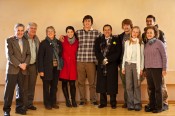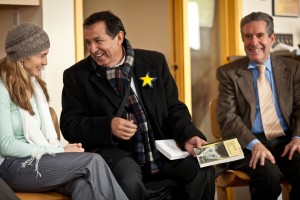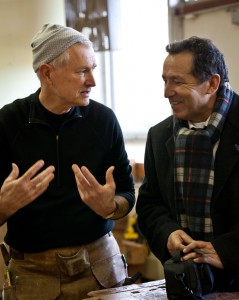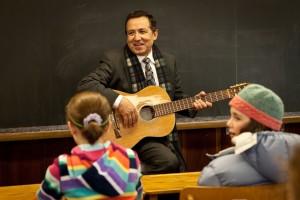Waldorf News
“This Is What a School Is Meant to Be” – Ecuador’s Dr. Angel Castillo Visits American Waldorf Schools by Eugene Schwartz

In spite of its steady growth, and in spite of admirable efforts on the part of individual Waldorf schools and the leadership of AWSNA, Waldorf education has attracted the attention of no one with the clout and stature to transform education on a large scale. A notable exception to this rule was the recent visit of Dr. Angel Castillo to three Waldorf schools in the United States.
Dr. Castillo is the Minister of Education in Imbabura, a large province in Ecuador. After a long period of dormancy, a new President has laid out ambitious plans to reform the Ecuadorian public school system. Dr. Castillo’s visit was a state-mandated mission to establish partnerships with American universities – and to explore Waldorf education as a potential alternative to the test-driven and intellectually-oriented methodologies that are so prevalent in the northern hemisphere. This visit was arranged by Sue Brown and Paul Murtha of Mountains of Hope, a social/educational/service initiative that has been active in Ecuador for several years.
 Since the Minister’s university stops were in eastern Pennsylvania, Sue called upon the Waldorf educator Eugene Schwartz to arrange visits with schools in that area that could exemplify Waldorf at its best. On very short notice, three schools agreed to host Dr. Castillo, and he was able to visit the Kimberton Waldorf School and the Camphill Children’s Village (the only Waldorf school for special-needs children in this country) on Monday, December 12, and the Waldorf School of Princeton on December 16, 2011. The Kimberton visit was beautifully choreographed by Caitlin Rodriguez Elberson, Associate Director of Development, and Lael Rasch, Admissions Director. It happened to be an Advent Monday, so Dr. Castillo’s first experience of Kimberton was the Advent Assembly, an all-school event held in the school’s auditorium. The large room, filled with students and parents, was lit with candle chandeliers, while the second-grade class sang and played their lyres. Two twelfth graders shared in the telling of a Hanukkah story to a rapt and enchanted audience. At its conclusion, children, teachers, and parents sang “People Look East.” It is hard to imagine any event that could represent the soul and spirit of Waldorf education as powerfully as that assembly – and this was only the beginning of Dr. Castillo’s visit.
Since the Minister’s university stops were in eastern Pennsylvania, Sue called upon the Waldorf educator Eugene Schwartz to arrange visits with schools in that area that could exemplify Waldorf at its best. On very short notice, three schools agreed to host Dr. Castillo, and he was able to visit the Kimberton Waldorf School and the Camphill Children’s Village (the only Waldorf school for special-needs children in this country) on Monday, December 12, and the Waldorf School of Princeton on December 16, 2011. The Kimberton visit was beautifully choreographed by Caitlin Rodriguez Elberson, Associate Director of Development, and Lael Rasch, Admissions Director. It happened to be an Advent Monday, so Dr. Castillo’s first experience of Kimberton was the Advent Assembly, an all-school event held in the school’s auditorium. The large room, filled with students and parents, was lit with candle chandeliers, while the second-grade class sang and played their lyres. Two twelfth graders shared in the telling of a Hanukkah story to a rapt and enchanted audience. At its conclusion, children, teachers, and parents sang “People Look East.” It is hard to imagine any event that could represent the soul and spirit of Waldorf education as powerfully as that assembly – and this was only the beginning of Dr. Castillo’s visit.
 For the rest of the morning, Dr. Castillo was afforded quick, but intense samplings of classes from Kindergarten to High School. Eugene Schwartz presented short previews of what Dr. Castillo would be seeing in the Grade School and the High School, and the main lesson books and crafts/handwork items that were on display also afforded a condensed view of what was to come. Throughout Dr. Castillo’s visit, Paul Murtha provided a remarkably fluent, ongoing simultaneous translation of all that transpired, while Lael Rasch and several other Spanish-speakers – including a group of high school students, some of whom had studied in Ecuador – made the Minister feel very much at home. Not your typical Minister, Dr. Castillo made every effort to establish contact with the children in each classroom. Coming upon a guitar lying on a bench in the High School, he quickly tuned it and began to play and sing; a few minutes later he treated the fifth graders to a song that he had written for his own class years before.
For the rest of the morning, Dr. Castillo was afforded quick, but intense samplings of classes from Kindergarten to High School. Eugene Schwartz presented short previews of what Dr. Castillo would be seeing in the Grade School and the High School, and the main lesson books and crafts/handwork items that were on display also afforded a condensed view of what was to come. Throughout Dr. Castillo’s visit, Paul Murtha provided a remarkably fluent, ongoing simultaneous translation of all that transpired, while Lael Rasch and several other Spanish-speakers – including a group of high school students, some of whom had studied in Ecuador – made the Minister feel very much at home. Not your typical Minister, Dr. Castillo made every effort to establish contact with the children in each classroom. Coming upon a guitar lying on a bench in the High School, he quickly tuned it and began to play and sing; a few minutes later he treated the fifth graders to a song that he had written for his own class years before.
Dr. Castillo’s own background, as he said time and again, almost seemed to be a preparation for this day. He had begun his educational career as a teacher of 6 – 7 year-olds, and recognized immediately that the push for early reading and computation skills was not what children needed. He told the parents of his students that he was going to let them play and engage in artistic activity, and in so doing he distinguished himself as a courageous – albeit lonely – educator. Through all of this, Dr. Castillo knew nothing of Waldorf education, yet even the book that he wrote at this time – Libre Mente: Educacion para formar librepensadores – (with a childhood photo of the pensive Angel Castillo on its cover) already echoes the phrase “Education Towards Freedom.” After a distinguished tour of duty organizing successful educational programs for prisoners, Dr. Castillo was appointed to the Ministry of Education.
 The morning ended with a reception with students and parents. High schoolers spoke of their experiences of the universality of the Waldorf experience; an eleventh-grader played violin; parents asked how they could help spark the unfolding of the Waldorf impulse in Ecuador. Eugene Schwartz had hung an Ecuadorian flag in the room, and he pointed to its unusually pictorial configuration. In the lower third, a Roman fasces, the symbol of power, lay horizontal and prone; in the upper third, a condor, sharp-eyed and awake, looked for prey; in the middle a huge lake lay serenely amidst mountains. Eugene went on: “The fasces symbolizes willing, the condor, thinking, and, in the middle, the equilibrium of water symbolizes the balance of the heart, the power of feeling. Thinking, feeling, and willing – Ecuador should be the perfect setting for Waldorf education.” The equally meaningful visits that Dr. Castillo was to have at the Camphill Village and the Waldorf School of Princeton made that connection even more emphatic.
The morning ended with a reception with students and parents. High schoolers spoke of their experiences of the universality of the Waldorf experience; an eleventh-grader played violin; parents asked how they could help spark the unfolding of the Waldorf impulse in Ecuador. Eugene Schwartz had hung an Ecuadorian flag in the room, and he pointed to its unusually pictorial configuration. In the lower third, a Roman fasces, the symbol of power, lay horizontal and prone; in the upper third, a condor, sharp-eyed and awake, looked for prey; in the middle a huge lake lay serenely amidst mountains. Eugene went on: “The fasces symbolizes willing, the condor, thinking, and, in the middle, the equilibrium of water symbolizes the balance of the heart, the power of feeling. Thinking, feeling, and willing – Ecuador should be the perfect setting for Waldorf education.” The equally meaningful visits that Dr. Castillo was to have at the Camphill Village and the Waldorf School of Princeton made that connection even more emphatic.
The morning came to an end, and it was time for Dr. Castillo to have lunch at the nearby Station Bistro (a restaurant started by a Kimberton alumna). Children wanted to pose for photos with him, and he wanted to continue his conversations with the numerous Spanish speakers who had joined his tour. He finally was pulled away to the parking lot, and there he stood, looking at the scores of children at play on the bucolic campus. The Minister began to weep. He touched his heart and said, “This means so much to me; this is what a school is meant to be.”
Photos by Nancy Coe.
 Summer Programs - Culminating Class Trips
Summer Programs - Culminating Class Trips The Journey is Everything
The Journey is Everything Quality Education in the Heartland
Quality Education in the Heartland Middle School Science With Roberto Trostli
Middle School Science With Roberto Trostli Dancing for All Ages
Dancing for All Ages Jamie York Books, Resources, Workshops
Jamie York Books, Resources, Workshops Apply Today: New Cohort Starts Nov. 2025
Apply Today: New Cohort Starts Nov. 2025 The Art of Administration and Leadership
The Art of Administration and Leadership Flexible preparation for your new grade
Flexible preparation for your new grade Train to Teach in Seattle
Train to Teach in Seattle Bringing Love to Learning for a Lifetime
Bringing Love to Learning for a Lifetime Everything a Teacher Needs
Everything a Teacher Needs Bay Area Teacher Training
Bay Area Teacher Training Waldorf EC Training & Intensives in Canada
Waldorf EC Training & Intensives in Canada Art of Teaching Summer Courses 2025
Art of Teaching Summer Courses 2025 Grade Level Training in Southern California
Grade Level Training in Southern California Transforming Voices Worldwide
Transforming Voices Worldwide Waldorf-inspired Homeschool Curriculum
Waldorf-inspired Homeschool Curriculum Immersive Academics and Arts
Immersive Academics and Arts Caring for All Stages of Life
Caring for All Stages of Life Roadmap to Literacy Books & Courses
Roadmap to Literacy Books & Courses Association for a Healing Education
Association for a Healing Education ~ Ensoul Your World With Color ~
~ Ensoul Your World With Color ~ Discovering the Wisdom of Childhood
Discovering the Wisdom of Childhood Space speaks. Its language is movement.
Space speaks. Its language is movement. Full-Time Teacher Education
Full-Time Teacher Education Storytelling Skills for Teachers
Storytelling Skills for Teachers RSS Feeds
RSS Feeds